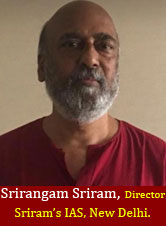The Cholaperiod is known for its aesthetic art and elaborate temple architecture. In this light, bring out the features of Chola temple architecture and Chola metal sculptural art. (250 words)
Sakshi Education
By Srirangam Sriram, Sriram's IAS, New Delhi.

Features of Chola metal sculptural art
The Chola period is well known for the aesthetic and technical finesse of its metal sculpture. Thanjavur was a major centre of the production of such images. 
There was an efflorescence and refinement in temple architecture and sculpture during the Chola period. While Chola rulers of Thanjavur developed the Dravidian style of temple architecture almost to perfection, they also perfected the metal sculptural art.

The period from the ninth to the thirteenth centuries in southern India is regarded as one of the most creative and formative periods of Tamil culture. Over the height of the Chola dynasty’s power in southern India, several stone temples were built, among which the great temples at Thanjavur, Gangaikonda cholapuram and Darasuram are often considered their finest artistic achievements for the monumentality of conception, architectural grandeur, powerful sculpture and fine painting.
Features of Chola temple architecture
Features of Chola temple architecture
- Sanctum: Early Chola temples consisted of Vimana (sanctum and its superstructure) joined to an ardhamandapa. The sanctum was made circular.
- Later additions: Later Chola temples also included addition of mukhamandapa and antarala (antechamber between Vimana and ardhamandapa). This can be seen in Brihadishvara temple.
- Gopuras:Temples stand within a huge rectangular enclosure, which were adorned with huge gopuras (temple gateways). The figures carved on gopuras are heavy and ornamented. Later, gopuras became more dominant than the Vimana.
- Shikharas: The shikharas of the Chola temple were elaborate with meticulous carving.
- Use of stones:The brick temples were rebuilt in stone during the Chola period.
- Outer sculptures: Pilasters divide the outer walls into niches, which contain images of various deities including Ganesha, Durga Mahishasuramardini and Brahma. Representations of deities and mythological scenes, including those from the Ramayana, appear on the outer walls.
Features of Chola metal sculptural art
The Chola period is well known for the aesthetic and technical finesse of its metal sculpture. Thanjavur was a major centre of the production of such images.
- The metal images of South India were solid and made through the lost wax method.
- Traditionally, the images are supposed to be made out of an alloy of five metals (copper, silver, gold, tin, and lead).
- The iconography and style of metal images were similar to those of their stone counterparts. The images were clothed and ornamented and formed part of temple rituals and ceremonials.
- The images of Shiva as Nataraja, appear frequently among Chola metal sculpture. Other themes include Krishna and the Alvar and Nayanmar saints. There are a few Buddhist images as well.
- Most popular among the Chola metal sculptures is the Nataraja which presents Shiva as lord of the cosmic dance of creation and destruction.

There was an efflorescence and refinement in temple architecture and sculpture during the Chola period. While Chola rulers of Thanjavur developed the Dravidian style of temple architecture almost to perfection, they also perfected the metal sculptural art.
Published date : 29 Oct 2020 02:32PM






